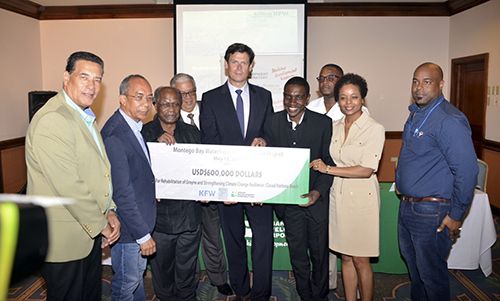
Clinton Pickering – Freelance Writer
The expectation that US$600,000 (approx. J$78M) had been secured from Germany’s KfW Development Bank in part funding to protect sections of Montego Bay’s coastline, has “bounced” and washed away with the tide of time.
That’s according to Andre Hylton, People’s National Party Caretaker for Central St. James, in an interview with the Western Mirror. Specifically, the money would have effected repairs to the groynes protecting the Closed Harbour (Dump Up), AquaSol and Gun Point Beaches over a 16-month period ahead of the $700 million Closed Harbour Beach Park development.
With the dangers of climate change more imminent and the promise of the beach park within 24 months, government has had to turn to its own resources to fund the repairing of the groynes.
Plans for the Closed Harbour Development were launched on Friday, May 12, 2017, at the Sunscape Resort, with the outlining of plans to carry out crucial repairs to Montego Bay’s waterfront infrastructure. It was stated then that, “As climate change makes its mark along the island’s coastline, the UDC has secured USD$600,000 in part funding from the KfW Development Bank through the Caribbean Community Climate Change Centre (CCCCC), to carry out rehabilitative works to protect infrastructure along sections of the Montego Bay Waterfront in St. James.”
The groynes, built perpendicular to the shoreline to reduce longshore drift and trap sediments, were constructed in the 1970’s during the UDC’s development works within the city and have deteriorated significantly, resulting in the loss of an estimated 7.7 acres of beach over the past 25 years. In addition to their rehabilitation, the project included exploring ecosystem-based adaptation interventions to complement the repair works.
WORD LEAKED
Word leaked out last week at the Private Sector Organization of Jamaica’s (PSOJ) Montego Bay Invasion forum at Jewel Grande under the theme: ‘Confront Climate & Disaster Risk: Prepare or Perish’, with a panel discussion on matters regarding disaster risk and climate change preparedness, particularly for Western Jamaica, and what mitigation and resilience plans/policies are being implemented by the public and private sector.
During a question-and-answer session, UDC’S Manager for Natural Resources Management and Environmental Planning, Dr Sean Townsend, commented on a question regarding what was being done about coastal protection to prevent sea level rise and the impact on the infrastructure.
“When we do projects and proposals, everybody gravitates to work with us when it is just infrastructural work because you can put a plaque up, you can identify and say this is what we have done, we have contributed to it. When we need to do a programme that is going to result in planting of sea grass or enhancing coral reefs, it’s not that attractive, everybody agrees that it is important but the funding is not coming with it,” he said.
He added: “We speak a lot about public-private partnership but the funding doesn’t come along with the conversation. For instance, you talk about the vulnerability of Montego Bay. The project for Closed Harbour Bay is going ahead; it’s started and there’s physical signs of it. Before that was to happen, the groynes were supposed to be rehabilitated, which would have resulted in significant infrastructural protection but yet still, that has been pushed back because the funding has not come forth.”
NO NEED TO FEAR
When contacted, Chairman of the UDC’s Montego Bay Advisory Committee, Winston Dear, disclosed that the US$600,000 funding fell through because it was being made available under a special environmental protection programme and the time had lapsed. But while sharing concern that development of the Closed Harbour Beach Park would be under threat without the rehabilitation of the groynes, he said there was no need to worry as the government had committed to providing the funds to get it done.
The total cost of rehabilitating the groynes is an estimated US$3 million, but while the Tourism Enhancement Fund is financing the Closed Harbour Beach Park, it is not being called upon for additional support to repair the groynes.
In 2017, as Minister without Portfolio in the Ministry of Economic Growth and Job Creation, Dr Horace Chang, noted, the entire Montego Bay waterfront, from the Freeport to the beach zone where the rehabilitation will take place, had been earmarked for “environmentally friendly development that can become a major attraction for the entire region.”
UDC General Manager, Dr. Damian Graham, stated at the project launch that it was critical to the protection of the Montego Bay shoreline, “Not just to address erosion, but also to minimize the impact from coastal flooding that can and will happen as we have more erratic behaviours in Mother Nature.”
He underscored that, “The repair of the groynes is paramount to the sustainability of a world-class multi-zoned public space which we hope to establish shortly”, and that the undertaking was aligned with the vision of Montego Bay becoming a leading city in the Western Hemisphere by minimizing physical and social blight, improving economic and social conditions.



I do trust all the ideas you have introduced to your post. They are very convincing and can certainly work. Still, the posts are very short for novices. May just you please lengthen them a little from subsequent time? Thank you for the post.
I want to to thank you for this good read!!I certainly loved every bit of it. I’ve got you saved as a favorite to look at new stuff you post…
Really enjoyed this article.Thanks Again.